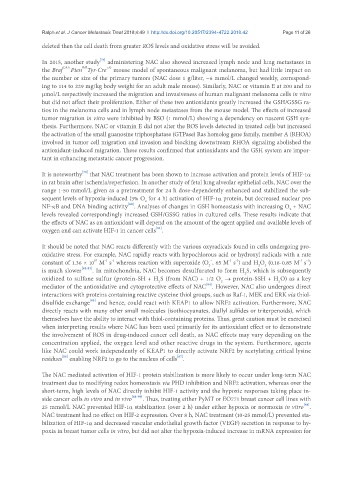Page 591 - Read Online
P. 591
Ralph et al. J Cancer Metastasis Treat 2018;4:49 I http://dx.doi.org/10.20517/2394-4722.2018.42 Page 11 of 26
deleted then the cell death from greater ROS levels and oxidative stress will be avoided.
[76]
In 2015, another study administering NAC also showed increased lymph node and lung metastases in
fl/fl
+/0
the Braf CA/+ Pten Tyr-Cre mouse model of spontaneous malignant melanoma, but had little impact on
the number or size of the primary tumors (NAC dose 1 g/liter, ~6 mmol/L changed weekly, correspond-
ing to 114 to 229 mg/kg body weight for an adult male mouse). Similarly, NAC or vitamin E at 200 and 20
μmol/L respectively increased the migration and invasiveness of human malignant melanoma cells in vitro
but did not affect their proliferation. Either of these two antioxidants greatly increased the GSH/GSSG ra-
tios in the melanoma cells and in lymph node metastases from the mouse model. The effects of increased
tumor migration in vitro were inhibited by BSO (1 mmol/L) showing a dependency on nascent GSH syn-
thesis. Furthermore, NAC or vitamin E did not alter the ROS levels detected in treated cells but increased
the activation of the small guanosine triphosphatase (GTPase) Ras homolog gene family, member A (RHOA)
involved in tumor cell migration and invasion and blocking downstream RHOA signaling abolished the
antioxidant-induced migration. These results confirmed that antioxidants and the GSH system are impor-
tant in enhancing metastatic cancer progression.
[79]
It is noteworthy that NAC treatment has been shown to increase activation and protein levels of HIF-1α
in rat brain after ischemia/reperfusion. In another study of fetal lung alveolar epithelial cells, NAC over the
range 1-50 mmol/L given as a pretreatment for 24 h dose-dependently enhanced and stabilized the sub-
sequent levels of hypoxia-induced (3% O for 4 h) activation of HIF-1α protein, but decreased nuclear p65
2
[80]
NF-κB and DNA binding activity . Analyses of changes in GSH homeostasis with increasing O + NAC
2
levels revealed correspondingly increased GSH/GSSG ratios in cultured cells. These results indicate that
the effects of NAC as an antioxidant will depend on the amount of the agent applied and available levels of
[81]
oxygen and can activate HIF-1 in cancer cells .
It should be noted that NAC reacts differently with the various oxyradicals found in cells undergoing pro-
oxidative stress. For example, NAC rapidly reacts with hypochlorous acid or hydroxyl radicals with a rate
constant of 1.36 × 10 M s whereas reaction with superoxide (O , 65 M s ) and H O (0.16-0.85 M s )
-1 -1
−
10
-1 -1
-1 -1
2
2
2
is much slower [82,83] . In mitochondria, NAC becomes desulfurated to form H S, which is subsequently
2
oxidized to sulfane sulfur (protein-SH + H S (from NAC) + 1/2 O → protein-SSH + H O) as a key
2
2
2
[84]
mediator of the antioxidative and cytoprotective effects of NAC . However, NAC also undergoes direct
interactions with proteins containing reactive cysteine thiol groups, such as Raf-1, MEK and ERK via thiol-
[85]
disulfide exchange and hence, could react with KEAP1 to allow NRF2 activation. Furthermore, NAC
directly reacts with many other small molecules (isothiocyanates, diallyl sulfides or triterpenoids), which
themselves have the ability to interact with thiol-containing proteins. Thus, great caution must be exercised
when interpreting results where NAC has been used primarily for its antioxidant effect or to demonstrate
the involvement of ROS in drug-induced cancer cell death, as NAC effects may vary depending on the
concentration applied, the oxygen level and other reactive drugs in the system. Furthermore, agents
like NAC could work independently of KEAP1 to directly activate NRF2 by acetylating critical lysine
[86]
[87]
residues enabling NRF2 to go to the nucleus of cells .
The NAC mediated activation of HIF-1 protein stabilization is more likely to occur under long-term NAC
treatment due to modifying redox homeostasis via PHD inhibition and NRF2 activation, whereas over the
short-term, high levels of NAC directly inhibit HIF-1 activity and the hypoxic responses taking place in-
side cancer cells in vitro and in vivo [88-90] . Thus, treating either PyMT or EO771 breast cancer cell lines with
[88]
25 mmol/L NAC prevented HIF-1α stabilization (over 2 h) under either hypoxia or normoxia in vitro .
NAC treatment had no effect on HIF-2 expression. Over 8 h, NAC treatment (10-25 mmol/L) prevented sta-
bilization of HIF-1α and decreased vascular endothelial growth factor (VEGF) secretion in response to hy-
poxia in breast tumor cells in vitro, but did not alter the hypoxia-induced increase in mRNA expression for

